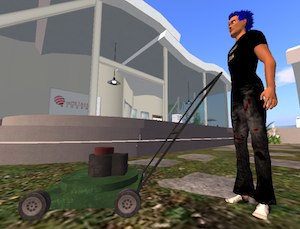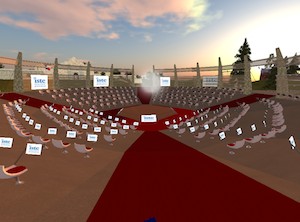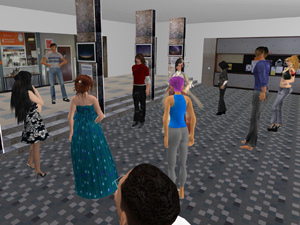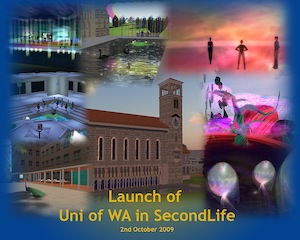1. The Hindu (India) – Brave new worlds beckon. “Everyone has indulged in a little escapism sometime in their lives. The need for an outlet from the relentless glare of reality is felt by many and the possibility of an alternate lifestyle hidden from public view can be a powerful attraction. This a lternate role-play starts at childhood with girls playing make-believe games with dolls and boys dreaming up war games with their action heroes. As age advances, the need for fantasy it seems, does not always diminish, it sometimes gets hidden under the wraps. In the past, people’s fantasy world went as far as books or movies could take them. Today the Internet can transport you to worlds beyond your wildest imagination.”
2. TechCrunch (USA) – PlaySpan Strikes Deal With Nickelodeon To Power Microtransactions. “We just wrote about PlaySpan’s recent study showing positive growth in the exchange and e-commerce of virtual goods exchange. PlaySpan powers micro-payments across over 1,000 video games and virtual worlds and has virtual goods storefronts on Facebook, MySpace, within games and on its standalone site. Today, PlaySpan is announcing a fairly significant deal with Nickelodeon to power payment services for virtual goods and microtransactions for the Nickelodeon Kids and Family Virtual Worlds Group.”
3. PhyOrg.com (UK) – Researchers bring noise to virtual worlds. “When you kick over a garbage can, it doesn’t make a pure, musical tone. That’s why the sound is so hard to synthesize. But now Cornell computer scientists have developed a practical method to generate the crashing and rumbling sounds of objects made up of thin “harmonic shells,” including the sounds of cymbals, falling garbage cans and lids, and plastic water-cooler bottles and recycling bins. The work by graduate students Jeffrey Chadwick and Steven An and Doug James, associate professor of computer science, will be presented at the SIGGRAPH Asia conference in Yokohama, Japan, in December.”
4. CNET (USA) – Virtual-goods resellers on the rise. “Gamers are not just making purchases to enhance their gaming experience but also selling virtual assets to other players, according to new research from video game market research firm VGMarket.
Sales of virtual goods are expected to reach $1 billion this year and already generate near $4 billion annually in China. But there are some challenges, primarily the fact that once you convert your real money to virtual cash you can’t readily get the dough back out.”
5. The Guardian (UK) – Google Earth beware: the Brits are coming. “I intended to give the 3D internet a miss for a while after writing last week. But that was before Mike Fotoohi, a freelance software engineer from London, emailed me. When he told me that he and a few friends, working for five years in their spare time, had built a 3D version not just of capital cities, as others have, but of the entire planet that was better than Google Earth, my first reaction was to get off the phone pronto.”
6. Reuters (USA) – Shapiro Negotiations Institute Opens New Training Centers Inside the Sistine Chapel, at the North Pole, at Camden Yards, and on Mt. Everest. “Shapiro Negotiations Institute (SNI) today launched a new online, 3-D approach to corporate training and education that delivers dramatic results and has the potential to change perceptions and expectations of such programs worldwide. Virtual Training Partners moves the experience of learning from conference rooms to the online, virtual world of Second Life, where participants and instructors interact as avatars in dynamic, ever-changing environments. The result? A program that costs dramatically less to provide, avoids lengthy time out of the office, and delivers effective new skills for participants that can be implemented immediately. ”
7. The Straits Times (Singapore) – Street cred in a virtual world. “I AM a midnight voyeur. But it’s not what you are thinking. Not the type that stares out of the window in the middle of the night, through high-powered goggles, searching for live porn action. My time is spent flipping through the profiles of my friends on Xbox LIVE – the online part of the Xbox 360 game console, which among other things, lets me connect to my friends and challenge them to virtual death matches. And this I usually do at the stroke of 12, which is when I get my free time in my daily busy working schedule. What I am looking for? Xbox Achievement points.”
8. VentureBeat (USA) – China’s growing addiction: online farming games. “A new agrarian revolution has occured in China, but only in the virtual worlds of social games. Social farm games now dominate all major Chinese social networking sites — RenRen (formerly Xiaonei), Kaixin001, 51.com, and QQ’s QZone. The May launch and 2H 2009 adoption of QQ Farm — a version of China’s already popular Happy Farm game built to run on Tencent’s estimated 228 million active-user QZone platform — may very well have transformed China into the leading country of online farmers. According to Five Minutes, Shanghai-based game developer of the first and largest social farm game, Happy Farm has now surpassed 23 million daily active users (DAU) across QZone, RenRen, and 51.com.The DAU count is the total number of users who log in during a 24-hour period.”
9. The Guardian (UK) – The rise of urban gaming. “Although we’d all like to think that we can completely separate our virtual and real-world experiences, it’s never quite as simple as that. Who hasn’t, at one point or another, emerged from a ten-hour Counter Strike session only to scour the street for camping spots? And conversely, surely you’ve had moments where you spot a cool building or rundown industrial area and think, ‘that would make a hell of game level’. I think, through the omnipresence of game culture and conventions, and the growing popularity of virtual worlds in general, our sense of reality is becoming more plastic; our interactions with the world around us more playful. I don’t think parkour could have evolved in a pre-videogame world – it’s games that have taught us to see scenic objects as potentially interactive components. ”
10. Christian Today (USA) – Brick-and-mortar pastor defends virtual churches. “The Christian church is engaging far less than one per cent of the 70 million people who are active in the virtual world. This means the virtual world is by far the largest unreached people group on planet Earth, says one pastor. Douglas Estes, a pastor from San Jose, California, has no vested interest in virtual or internet churches – a relatively new phenomenon – but given the large “unreached” population on the internet, he says he has a desire to see healthy churches proliferate “regardless of context”. Although he leads a brick and mortar church – Berryessa Valley Church – Estes defends virtual churches against critics in his new book, SimChurch: Being the Church in the Virtual World, maintaining that they are real churches with real people.”
 Although it’s mostly a throwback to the mid to late 20th Century, there’s still a significant cohort of Australians who associate mowing the lawn with the ‘Aussie lifestyle’ (I hate generalisations, but bear with me). There’s no shortage of people who still dream of owning their own land, on which they can inflict the weekly spring and summer routine of mowing the lawn. Last weekend I had the opportunity to do some lawn mowing, and it occurred to me that for widepsread adoption of virtual environments to occur, the in-world experience needs to be a lot more like mowing the lawn. Keep reading to see a metaphor beaten within an inch of its life.
Although it’s mostly a throwback to the mid to late 20th Century, there’s still a significant cohort of Australians who associate mowing the lawn with the ‘Aussie lifestyle’ (I hate generalisations, but bear with me). There’s no shortage of people who still dream of owning their own land, on which they can inflict the weekly spring and summer routine of mowing the lawn. Last weekend I had the opportunity to do some lawn mowing, and it occurred to me that for widepsread adoption of virtual environments to occur, the in-world experience needs to be a lot more like mowing the lawn. Keep reading to see a metaphor beaten within an inch of its life.
 The mini-launch of the UWA sims occurred in August, well before the campus was complete. Jayjay Zifanwe and Ted Snell worked feverishly for several weeks and at least one whole weekend to ready the Astronomy art gallery in the SL Physics building for the occasion.
The mini-launch of the UWA sims occurred in August, well before the campus was complete. Jayjay Zifanwe and Ted Snell worked feverishly for several weeks and at least one whole weekend to ready the Astronomy art gallery in the SL Physics building for the occasion. On the launch day of the UWA sims, 40 people attended the ceremony as avatars in Second Life, and 120 people packed into a RL space to attend. The people in the physical space were able to follow the proceedings in SL; the SL folk able to view the video kindly relayed the action for the other people unable to view the video through SL.
On the launch day of the UWA sims, 40 people attended the ceremony as avatars in Second Life, and 120 people packed into a RL space to attend. The people in the physical space were able to follow the proceedings in SL; the SL folk able to view the video kindly relayed the action for the other people unable to view the video through SL. Over the past year, the hype around virtual goods as the next big thing has continued unabated. Like the hype surrounding virtual worlds, it’ll eventually ease off, but underneath that is the reality of the very significant growth that is continuing. Two recent announcements have really emphasised that growth.
Over the past year, the hype around virtual goods as the next big thing has continued unabated. Like the hype surrounding virtual worlds, it’ll eventually ease off, but underneath that is the reality of the very significant growth that is continuing. Two recent announcements have really emphasised that growth.  A game currently under development has caught my interest lately. It’s CCP’s DUST514 – a console based MMOFPS that is aiming to tie in with CCP’s
A game currently under development has caught my interest lately. It’s CCP’s DUST514 – a console based MMOFPS that is aiming to tie in with CCP’s
Recent Comments